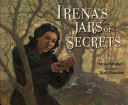
Irena Sendler, born to a Polish Catholic family, was raised to respect people of all backgrounds and to help those in need. She became a social worker; and after the German army occupied Poland during World War II, Irena knew she had to help the sick and the starving Jews who were imprisoned in the Warsaw Ghetto. She began by smuggling food, clothing and medicine into the ghetto, then turned to smuggling children out of the ghetto. Using false papers and creative means of escape, and at great personal risk, Irena helped rescue Jewish children and hides them in safe surroundings. Hoping to reunite families after the war, Irena kept lists of the Children’s identities.
Motivated by conscience and armed with compassion and a belief in human dignity, Irena Sendler confronted an enormous moral challenge and proved to the world that an ordinary person can accomplish deeds of extraordinary courage.
- ISBN: 9781600604393
- Published: 2011 , Lee & Low Books
- Themes: Courage, Holocaust, identities, Jews, Survival
- Descriptors: Biography - Autobiography- Memoir, Europe, Nonfiction, Picture Book, Poland, Primary (ages 6-9)
- No. of pages: 40

I agree, Tracy, this would be a moving and suspenseful movie. I would go to see it!
I was caught up in this story from the onset. I think the illustrations are what captured my attention first. I noticed how the visual elements of Ron Mazellan’s illustrations (especially his use of color and tone) enhance the feeling of danger in Vaughan’s straightforward depiction of Irena’s ruse to sneak children out of the ghetto. The story itself is captivating. Irena was so brave, risking her life many times over to rescue the children. Readers of all ages will connect to Irena in some fashion.
Recently, I’ve come to appreciate the afterword sections authors are including in the picture books they write. Books such as The Donkey of Gallipoli (Greenwood), and The Third Gift (Park), both featured in My Take/ Your Take this month have an afterword that enhances each story to the degree that without that section, I don’t think I would have enjoyed the stories as much as I did. Like the books mentioned above, the afterword in Irena’s Jars of Secrets contains interesting information about the work Irena did for the underground organization Zegota, the Council for Aid to Jews. It also tells about Irena’s life after the war until her death in 2008. I wonder how others feel about the afterword sections in books. Does the information enhance the story or detract from it? Should the author have included some or all of the information in the story? Do readers think the information in the afterword lends credibility to the story? I look forward to reading others’ responses to these questions.
I think it would be difficult to craft a fictional story that rivals the suspense and bravery of the real life story of Irena Sendler. What she accomplished during War World II, rescuing 2,500 children from the Nazi concentration camps, and almost losing her own life when captured by the Gestapo and sentenced to death is riveting to read, and Marcia Vaughn’s prose coupled with Ron Mazellan’s illustrations tell this important story powerfully. I think this story should be turned into a major motion picture like Shindler’s List. I am grateful a quality children’s book has been written about this historical event so the marvel of this extraordinary woman is remembered for generations.